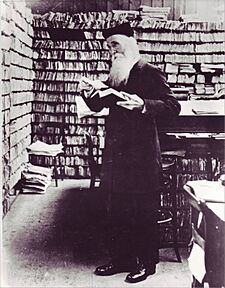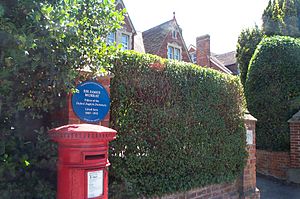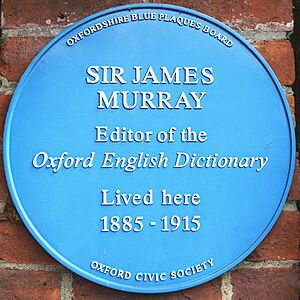James Murray (lexicographer) facts for kids
Quick facts for kids
Sir James Murray
|
|
|---|---|

Murray in the Scriptorium at Banbury Road, before 1910
|
|
| Born | James Murray 7 February 1837 Denholm, Roxburghshire, Scotland |
| Died | 26 July 1915 (aged 78) Oxford, England |
| Occupation | Academic, lexicographer, philologist |
| Nationality | British |
| Spouse |
|
| Children | 11 (incl. Harold Murray and Oswyn Murray) |
Sir James Augustus Henry Murray was a British expert on words and languages. He is famous for being the main editor of the Oxford English Dictionary (OED). He worked on this huge dictionary from 1879 until he passed away in 1915.
Contents
James Murray's Life and Learning
James Murray was born in a small village called Denholm in Scotland. He was the oldest son of a fabric seller. James was a very smart child who loved to learn. He had to leave school at age 14 because his family could not afford the fees.
At 17, he became a teacher at Hawick Grammar School. Three years later, he was the headmaster of another school there. In 1856, he helped start the Hawick Archaeological Society.
In 1861, James married Maggie Scott. Sadly, their daughter Anna passed away young. Maggie also became very ill. Doctors suggested they move to London for her health. James got a job at a bank there. Maggie passed away about a year after they moved.
A year later, James got engaged to Ada Agnes Ruthven. They married the next year. Their good friend Alexander Graham Bell, who invented the telephone, was their best man.
James was very interested in languages and where words come from (called etymology). He knew many languages, including French, Latin, German, and Russian. He also studied older languages like Anglo-Saxon.
By 1869, James was part of the Philological Society. In 1873, he left his bank job to teach again at Mill Hill School. He also wrote a book about the Scottish dialect.
James and Ada had eleven children. All of them helped him with the Oxford English Dictionary. This was quite unusual for the time, as many children did not survive to adulthood. His son, Harold James Ruthven Murray, became a famous chess historian.
James Murray passed away on July 26, 1915. He asked to be buried in Oxford next to his best friend, James Legge.
Murray and the Oxford English Dictionary
In 1878, James Murray was asked to come to Oxford. The Oxford University Press wanted him to edit a new dictionary of the English language. This dictionary would replace an older one and include all the words used in English, with all their different meanings.
On March 1, 1879, James agreed to edit this new dictionary. It was planned to be about 7,000 pages long and take ten years to finish. But it grew much bigger! When it was finally published in 1928, it had twelve volumes. It defined 414,825 words and used over 1.8 million examples to show how words were used.

To help with the work, Murray built a special shed at Mill Hill School. He called it the Scriptorium. This shed held his small team of helpers and thousands of paper slips. These slips had quotes from books and writings that showed how words were used. People from all over the world sent in these slips. As the dictionary work grew, Murray stopped teaching and became a full-time word expert.
In 1884, Murray and his family moved to a large house in Oxford. He had a bigger Scriptorium built in their garden. It had more space for all the slips that kept arriving. So much mail was sent to "Mr Murray, Oxford" that the Post Office put a special post box outside his house!
Murray kept working on the dictionary even as he got older. He was even made a knight in 1908 for his amazing work.
An important helper for the OED was William Chester Minor. He sent in many useful quotes for the dictionary. Murray once said that they could illustrate the last four centuries of words just from Minor's contributions.
In Books and Movies
The book The Surgeon of Crowthorne (also called The Professor and the Madman) by Simon Winchester was published in 1998. It tells the story of William Chester Minor and his help with the Oxford English Dictionary.
This book was made into a movie called The Professor and the Madman. It stars Mel Gibson as James Murray and Sean Penn as William Chester Minor. The movie came out in 2019.
In 2003, Simon Winchester wrote another book, The Meaning of Everything: The Story of the Oxford English Dictionary. This book tells the full story of the dictionary, from its start to its completion.
The Dictionary of Lost Words (2020) is a popular novel by Australian author Pip Williams. Much of this story takes place in the Scriptorium where Murray and his team worked on the OED.
Honorary Degrees
James Murray received special honorary degrees from nine universities. These included:
- A law degree (LL.D) from the University of Glasgow in 1901.
- A literature degree (D.Litt.) from the University of Oxford in 1914.


